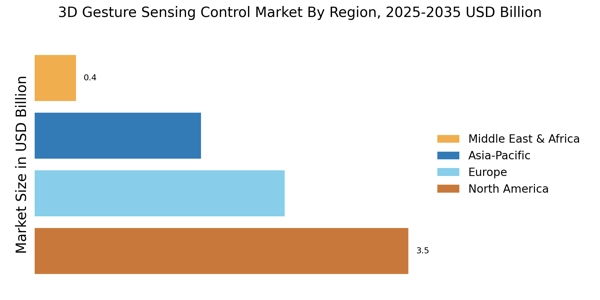Growth of Smart Home Devices
The proliferation of smart home devices is a significant driver for the 3D Gesture Sensing Control Market. As consumers increasingly adopt smart technologies for convenience and efficiency, the integration of gesture control systems becomes more prevalent. Market analysis suggests that the smart home market is expected to reach a valuation of several hundred billion dollars in the next few years, with gesture control being a key feature that enhances user interaction. This trend is likely to encourage manufacturers to incorporate 3D gesture sensing capabilities into their products, thereby expanding the market. The ability to control devices through simple hand movements not only adds a layer of sophistication but also aligns with the growing preference for intuitive and user-friendly interfaces.
Emergence of Wearable Technology
The emergence of wearable technology is another critical driver of the 3D Gesture Sensing Control Market. As wearables become more sophisticated, the integration of gesture control features is increasingly common. Devices such as smartwatches and fitness trackers are now incorporating gesture recognition capabilities, allowing users to interact with their devices more intuitively. Market forecasts suggest that the wearable technology sector will continue to expand, with a growing emphasis on enhancing user experience through innovative control methods. This trend is likely to stimulate demand for 3D gesture sensing technologies, as manufacturers aim to differentiate their products in a competitive landscape. The 3D Gesture Sensing Control Market is thus positioned to capitalize on the advancements in wearable technology, driving further growth and innovation.
Advancements in Sensor Technology
Advancements in sensor technology are significantly influencing the 3D Gesture Sensing Control Market. Innovations in sensor design, such as improved accuracy and reduced latency, are enhancing the user experience. For instance, the development of more sensitive and compact sensors allows for more precise gesture recognition, which is crucial for applications in gaming, virtual reality, and smart home devices. Market data indicates that the sensor technology segment is anticipated to account for a substantial share of the overall market, driven by these technological improvements. As manufacturers continue to invest in research and development, the capabilities of 3D gesture sensing systems are likely to expand, further solidifying their role in various industries and applications.
Rising Demand for Touchless Interfaces
The increasing demand for touchless interfaces is a primary driver of the 3D Gesture Sensing Control Market. As consumers become more health-conscious, the need for hygienic interaction methods has surged. This trend is particularly evident in sectors such as healthcare and retail, where minimizing physical contact is essential. According to recent data, the market for touchless technology is projected to grow at a compound annual growth rate of over 20% in the coming years. This growth is likely to propel the adoption of 3D gesture sensing technologies, as they offer a seamless and intuitive way to interact with devices without the need for physical contact. Consequently, the 3D Gesture Sensing Control Market is expected to witness significant advancements and innovations to meet this rising demand.
Increased Investment in Augmented and Virtual Reality
The surge in investment in augmented and virtual reality (AR/VR) technologies is propelling the 3D Gesture Sensing Control Market. As industries such as gaming, education, and training increasingly adopt AR/VR solutions, the demand for advanced gesture recognition systems rises. Recent reports indicate that the AR/VR market is projected to grow exponentially, with significant funding directed towards developing immersive experiences. This growth is likely to drive the need for 3D gesture sensing technologies that facilitate natural interactions within virtual environments. Consequently, the 3D Gesture Sensing Control Market stands to benefit from this trend, as developers seek to create more engaging and interactive applications that leverage gesture control.


















Leave a Comment